10 Unit 43: Non-verbal Communication
Learning Objectives
 After reviewing this information, you will be able to
After reviewing this information, you will be able to
-
-
- understand and explain the principles of nonverbal communication
- understand general types of nonverbal communication
- understand the principles of active listening
-
Introduction
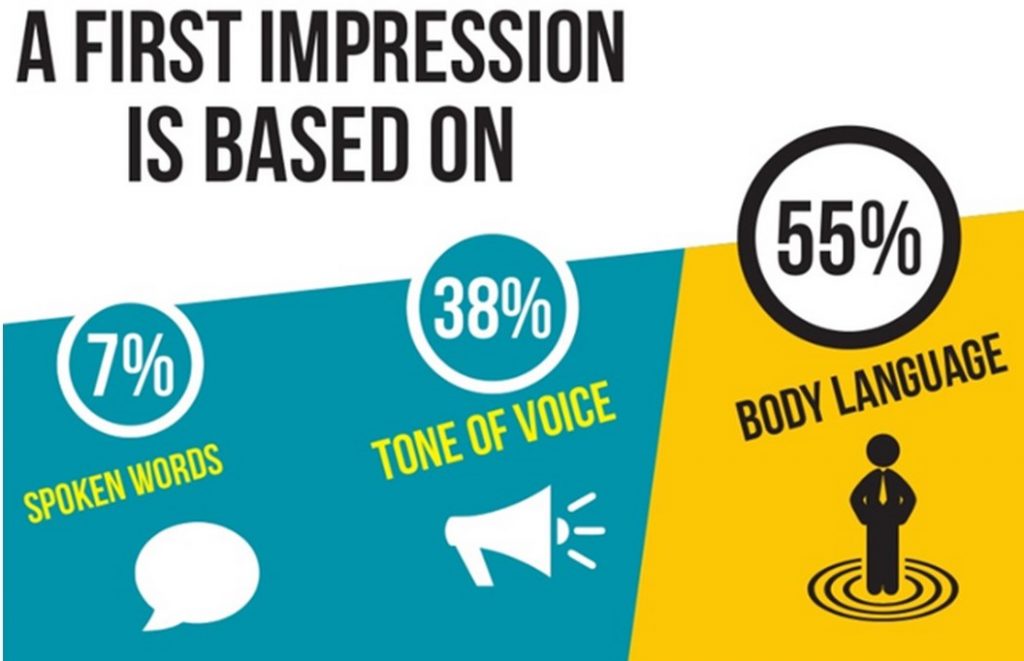
It’s not always what you say, but how you say it that makes a difference. We sometimes call this “body language,” or “nonverbal communication,” and it is a key aspect of effective business communication. Nonverbal communication is the process of conveying a message without the use of words. It can include gestures and facial expressions, tone of voice, timing, posture and where you stand as you communicate. It can help or hinder the clear understanding of your message, but it doesn’t reveal (and can even mask) what you are really thinking. Nonverbal communication is far from simple, and learning how to understand non-verbal skills will increase your effectiveness as a business communicator.
Knowledge Check
Types of Non-verbal Communication
How do you know when your boss or instructors are pleased with your progress (or not)? You might know from the smiles on their faces, from the time and attention they give you, or perhaps in other nonverbal ways, like a raise, a bonus, or a good grade. Whether the interaction takes place face-to-face, or at a distance, you can still experience and interpret nonverbal responses. Eight types of non-verbal communication are discussed below.
1. Body language
Body language is the way people situate their body naturally depending on the situation, the environment and how they are feeling. Different forms of body language include gestures, eye contact, posture and facial expressions. For example, think of all the times your parents have told you to stand up straight. The way you sit or stand communicates your comfort level, professionalism and general disposition towards a person or conversation. The image below explains the nonverbal cues communicated by each posture displayed.
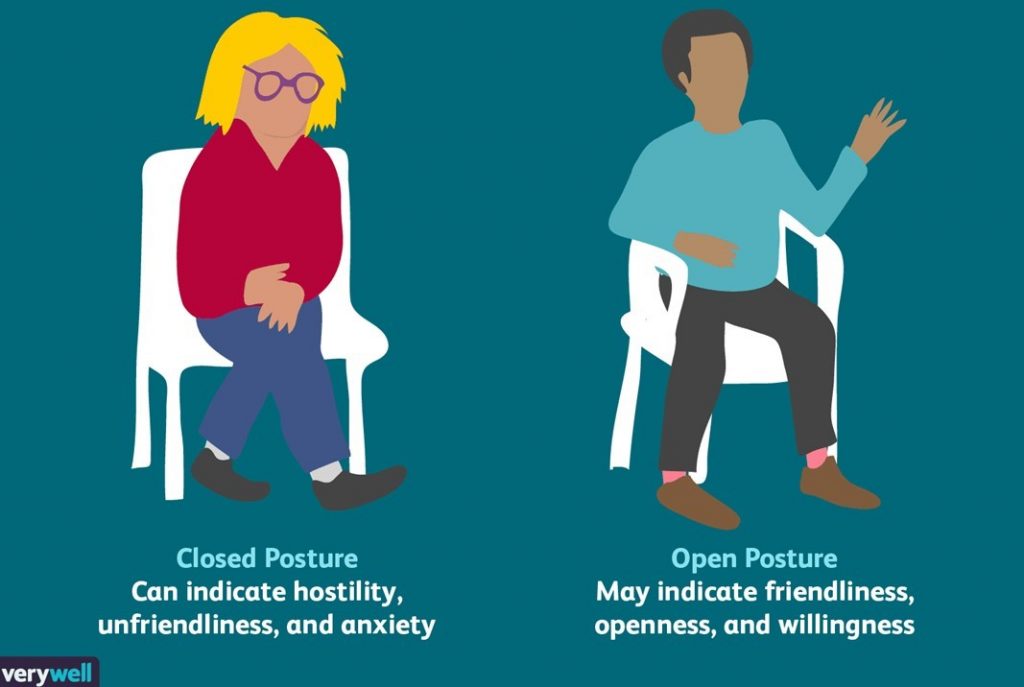
Numerous gestures are possible, and each gesture conveys something different. The range of possibilities is one of the reasons non-verbal communication is so complex. Review Figure 43.3 for a number of common gestures and their meaning.
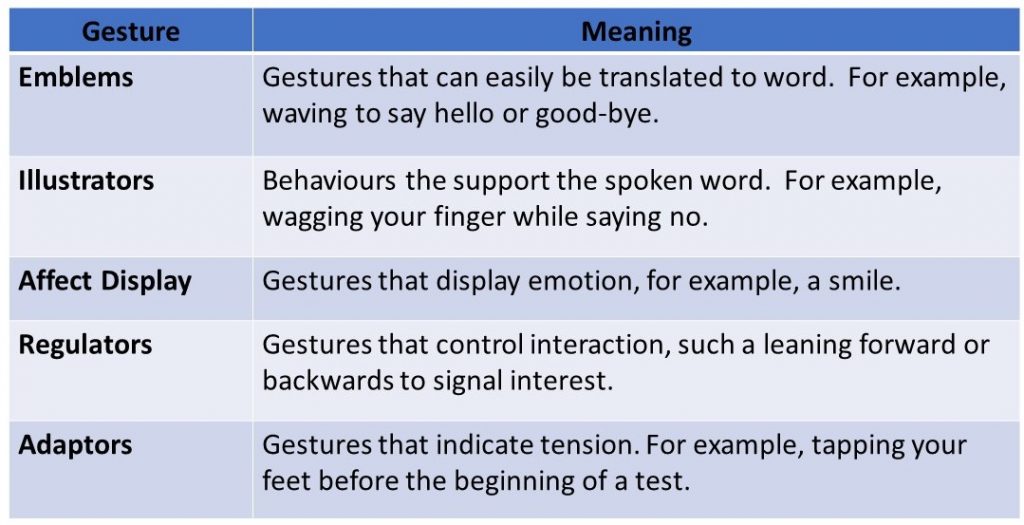
2. Space or Proxemics
The amount of space that exists between yourself and others communicates your comfort level, the importance of the conversation, your desire to support or connect with others, and the relative degree of power you hold. Space can be categorized into intimate, personal, social, and public. Review the image below for an overview of these categories.
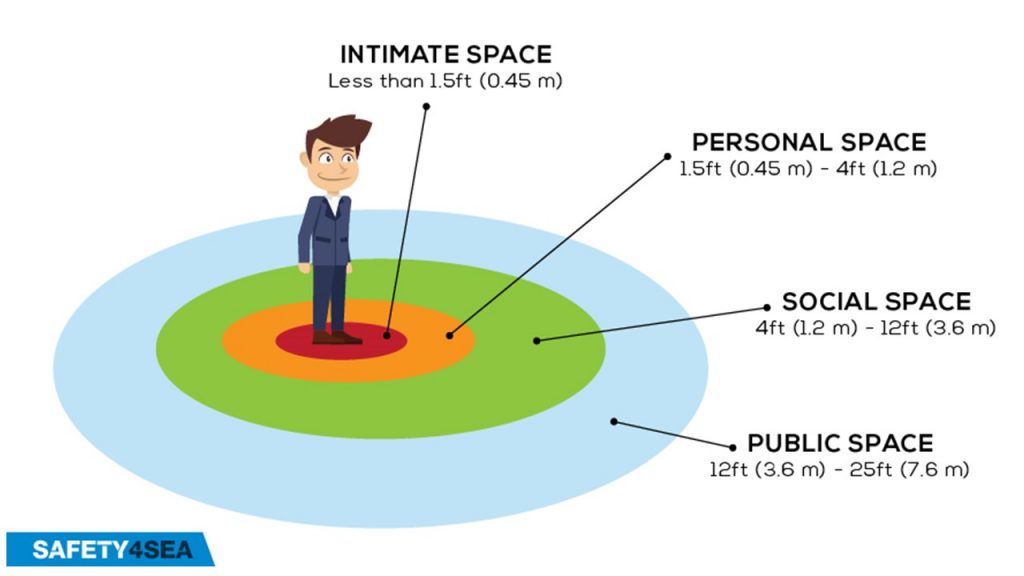
3. Paralanguage
Paralanguage includes the non-language elements of speech, such as your talking speed, pitch, intonation, volume and more. The saying “the meaning is in the person not in the words” applies here. Becoming an effective speaker involves understanding how to maximize and manage the specific qualities of your voice to clearly articulate your words and ideas.
5. Physical Characteristics
You didn’t choose your genes, your eye color, the natural color of your hair, or your height, but people spend millions every year trying to change their physical characteristics. You can get colored contacts; dye your hair; and if you are shorter than you’d like to be, buy shoes to raise your stature a couple of inches. Although some may find it superficial, the way we look affects the way we feel and how others perceive us. Research shows that we tend to think more positively of people deemed attractive. The work environment is no different. Take care that you are communicating the message you desire by cultivating your professional attire and look.
6. Touch
Touch is the most powerful form of nonverbal communication. Research shows that intimate contact is critical to the understanding of our own humanity. Over the last few years, the understanding of what is considered appropriate touching in the work environment is changing. Thus, although touch is of paramount importance, if inappropriate, it also carries the potential for the most problems.
7. Artifacts
Do you cover your tattoos when you are at work? Do you know someone who does? Expectations vary a great deal, and body art or tattoos may still be controversial in the workplace. Artifacts are forms of decorative ornamentation that are chosen to represent self-concept. They can include rings and tattoos, but may also include clothes, cars, watches, briefcases, purses, and even eyeglasses. Artifacts may project gender, role or position, class or status, personality, and group membership or affiliation. Paying attention to a customer’s artifacts may allow you to more accurately adapt your message to meet their needs.
8. Environment
Environment involves the physical and psychological aspects of the communication context. More than the tables and chairs in an office, the environment is an important part of the dynamic communication process. The perception of one’s environment influences one’s reaction to it. For example, Google is famous for its work environment, with spaces created for physical activity and even in-house food service around the clock. The expense is no doubt considerable, but Google’s actions speak volumes. In Google’s view, the results produced in the environment, designed to facilitate creativity, interaction, and collaboration, are worth the effort.
Knowledge Check
Developing Your Non-verbal Communication Skills
Nonverbal communication is an important aspect of business communication, from the context of interpersonal interaction to a public presentation. It is a dynamic, complex, and challenging aspect of communication. You are never done learning and adapting to your environment and context, and improving your understanding of nonverbal communication comes with the territory.
In order to be a successful business communicator, you will need to continually learn about nonverbal communication and its impact on your interactions. Below are three ways to develop your nonverbal communication skills.
Watch Reactions
Market research is fundamental to success in business and industry. So, too, you will need to do a bit of field research to observe how, when, and why people communicate the way they do. If you want to be able to communicate effectively with customers, you will need to anticipate not only their needs, but also how they communicate. They are far more likely to communicate with someone whom they perceive as being like them, than with a perceived stranger. From dress to mannerisms and speech patterns, you can learn from your audience how to be a more effective business communicator.
Enroll an Observer
Most communication in business and industry involves groups and teams, even if the interpersonal context is a common element. Enroll a coworker or colleague in your effort to learn more about your audience, or even yourself. They can observe you and note areas you may not have noticed that could benefit from revision. Perhaps the gestures you make while speaking tend to distract rather than enhance your communication. You can also record a video of yourself speaking with someone and play it to get a sense of how your nonverbal communication complements or detracts from the message.
Focus on a Specific Type of Nonverbal Communication
What is the norm for eye contact where you work? Does this change or differ based on gender, age, ethnicity, cultural background, context, environment? Observation will help you learn more about how people communicate; looking for trends across a specific type of nonverbal communication can be an effective strategy. Focus on one behaviour you exhibit, like pacing, hand gestures, or eye contact. Use nonverbal communication to enhance your message, watch reactions and consider enrolling an observer to help you become aware of your nonverbal habits and how your others receive nonverbal messages.
Knowledge Check
Active Listening
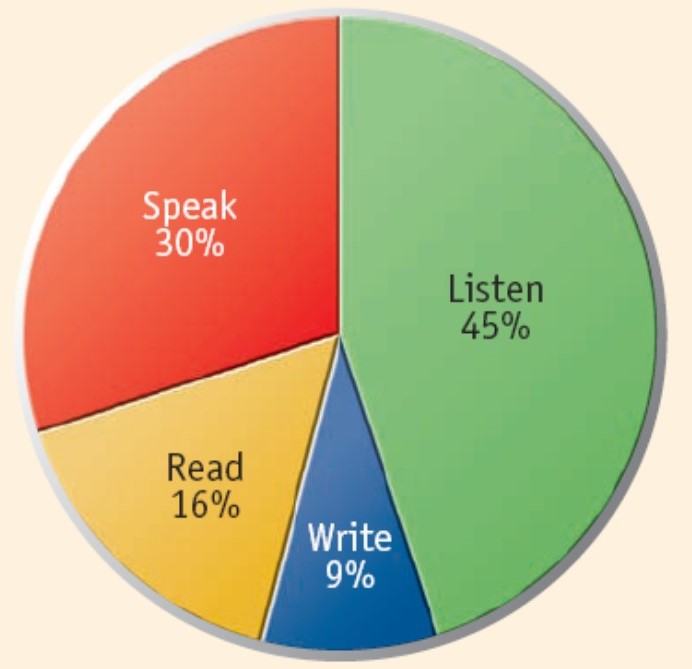
You may have experienced the odd sensation of driving somewhere and, having arrived, have realized you don’t remember driving. Your mind may have been filled with other issues, and you drove on autopilot. It’s dangerous when you drive on auto-pilot; similarly communicating on auto-pilot is also dangerous. Choosing to listen attentively takes effort. People communicate with words, expressions, and even in silence, and your attention to them will make you a better communicator. From discussions on improving customer service to retaining customers in challenging economic times, the importance of active listening comes up frequently as a success strategy.
There are five steps in the listening process: selecting, attending, understanding, remembering, and responding.
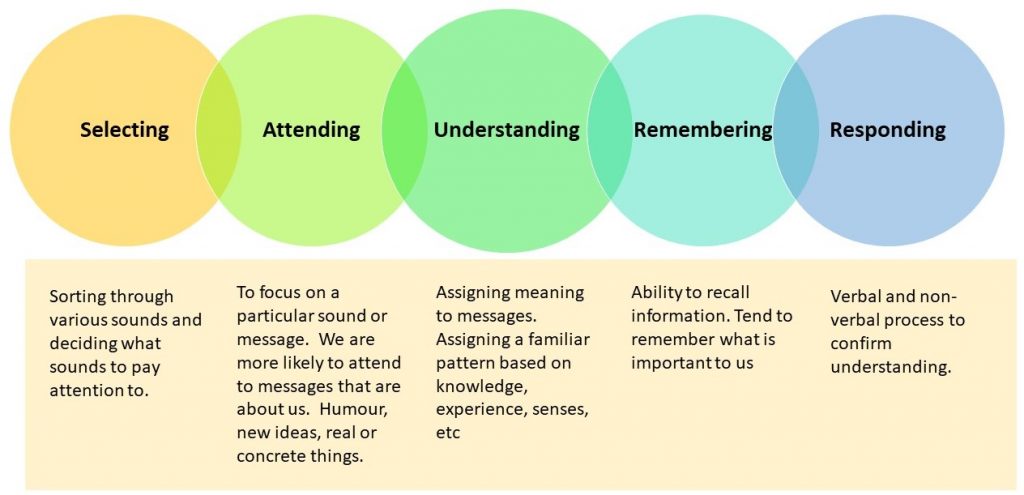
Here are some tips to facilitate active listening:
- Maintain eye contact with the speaker
- Don’t interrupt
- Focus your attention on the message, not your internal monologue.
- Restate the message in your own words and ask if you understood correctly.
- Ask clarifying questions to communicate interest and gain insight.
Our previous tips will serve you well in daily interactions, but suppose you have an especially difficult subject to discuss. In difficult situations, make an extra effort to create an environment that will facilitate positive communication.
Here are some tips that may be helpful:
- Set aside a special time. To have a difficult conversation, set aside time when you will not be disturbed.
- Don’t interrupt. Keep silent while you let the other person speak.
- Be nonjudgmental. Receive the message without judgment or criticism. Set aside your opinions, attitudes, and beliefs.
- Be accepting. Be open to the message being communicated, realizing that acceptance does not necessarily mean you agree with what is being said.
- Take turns. Wait until it is your turn to respond, and then measure your response in proportion to the message that was delivered to you. Reciprocal turn-taking allows each person have his say.
- Acknowledge. Let the other person know that you have listened to the message attentively.
- Understand. Be certain that you understand what the other person is saying. If you don’t understand, ask for clarification. Restate the message in your own words.
- Keep your cool. Speak your truth without blame. A calm tone will help prevent the conflict from escalating. Use “I” statements (e.g., “I felt concerned when I learned that my department is going to have a layoff”) rather than “you” statements (e.g., “you want to get rid of some of our best people”).
Knowledge Check
Conclusion
Recognize that mutual respect and understanding are built one conversation at a time. Trust is difficult to gain and easy to lose. Be patient and keep the channels of communication open, as a solution may develop slowly over the course of many small interactions. Recognize that it is more valuable to maintain the relationship over the long term than to “win” in an individual transaction.
Exercises

- Choose a television personality you admire. What do you like about this person? Watch several minutes of this person with the sound turned off, and make notes of the nonverbal expressions you observe. Turn the sound back on and make notes of their tone of voice, timing, and other audible expressions.
- Create a survey that addresses the issue of which people trust more, nonverbal or verbal messages. Ask an equal number of men and women and compare your results with those of your classmates.
References
Beebe, S. A., Beebe, S. J., Ivy, D. K. & Watson, S. (2005). Communication: Principles for a lifetime (Canadian rd.). Pearson Canada.
eCampus Ontario. (2018). Communications for business professional. Retrieved from https://ecampusontario.pressbooks.pub/commbusprofcdn/front-matter/introduction/
Guffey, M., Loewry, D., & Griffin, E. (2019). Business communication: Process and product (6th ed.). Toronto, ON: Nelson Education. Retrieved from http://www.cengage.com/cgi-wadsworth/course_products_wp.pl?fid=M20b&product_isbn_issn=9780176531393&template=NELSON
Indeed. (2020). The complete guide to nonverbal communication in the workplace. Career guide. Retrieved from https://www.indeed.com/career-advice/career-development/guide-to-non-verbal-communication
Lyon, A. (2020). Active listening skills [Video]. Youtube. https://www.youtube.com/watch?v=7wUCyjiyXdg
Purple Life Skills. (2020). 5 ways to improve your nonverbal skills [Video]. Youtube. https://www.youtube.com/watch?v=pU8cl_jBm3M
Safety4sea. (2020). Why body language is important in the workplace. Retrieved from https://pressbooks.senecacollege.ca/buscomm/wp-admin/post.php?post=2012&action=edit
Steemit. (2017). The importance of body language. Retrieved from https://steemit.com/knowledge/@kokuryo/the-importance-of-body-language
Take One Productions. (2014). Training, mindtools, body Language [Video]. Youtube. https://www.youtube.com/watch?v=3hUfU6-1WMI&feature=emb_rel_pause
Tedx Talks. (2017). Reading minds through body language [Video]. Youtube. https://www.youtube.com/watch?v=W3P3rT0j2gQ&feature=emb_logo
University of Minnesota Libraries Publishing. (2010). Business communications for success. Retrieved from https://open.lib.umn.edu/businesscommunication/front-matter/publisher-information/
Verywell Mind. (2017). Understanding body language and facial expressions. Behavioral psychology. Retrieved from https://www.verywellmind.com/understand-body-language-and-facial-expressions-4147228
Complex process of receiving, understanding and responding to verbal and non-verbal cues.
Sorting through various sounds and deciding what sounds to pay attention to.
To focus on a particular sound or message. We are more likely to attend to messages that are about us. Humour, new ideas, real or concrete things.
Assigning meaning to messages. Assigning a familiar pattern based on knowledge, experience, senses, etc.
Ability to recall information. Tend to remember what is important to us.
Verbal and non-verbal process to confirm understanding

